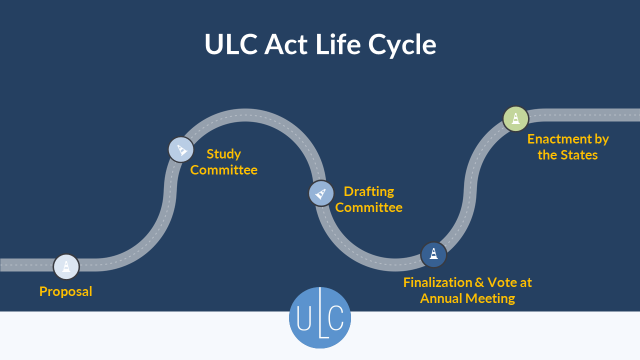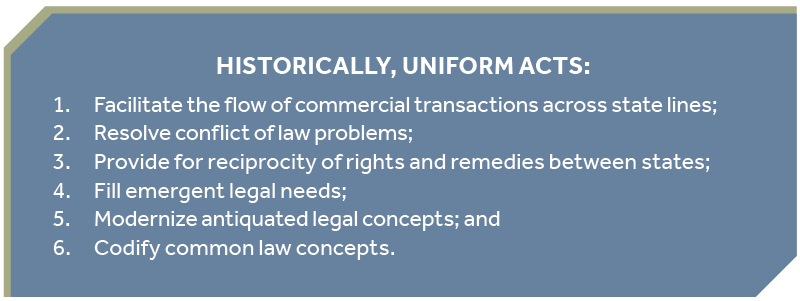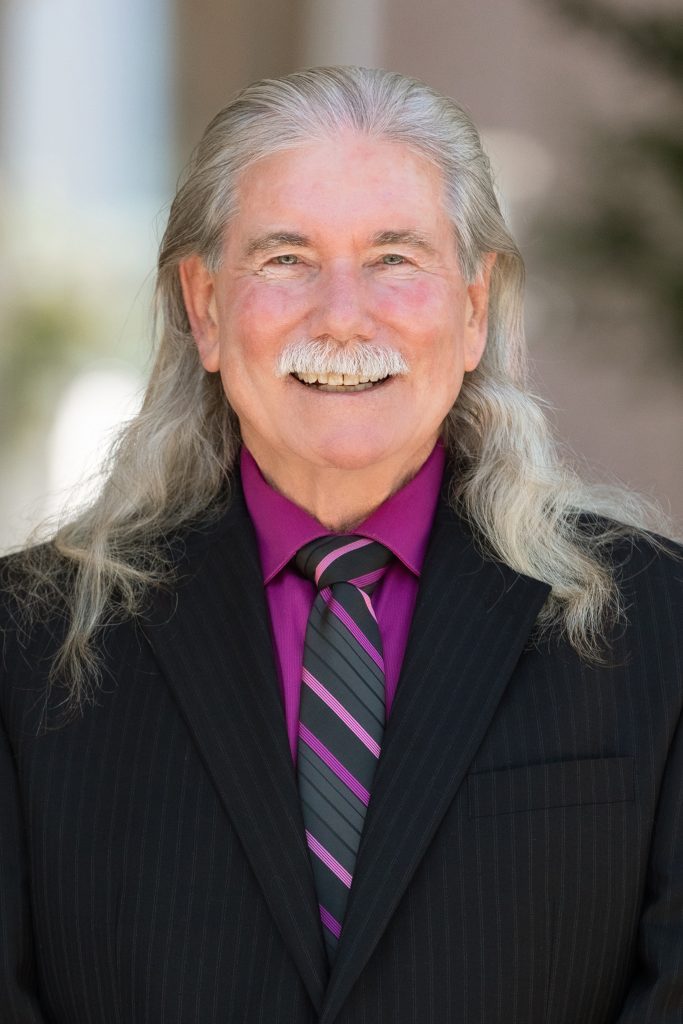Commissioner’s Column: What Is the Uniform Law Commission? by Hon. Robert L. Jackson

Perhaps it is not the same, considering over four decades have gone by since I was in law school, but I recall a class simply called “Sales.” In reviewing the University of Idaho’s book list for this fall, it appears a class dealing with the Uniform Commercial Code (“UCC”) still exists. The casebook is called Sales: A Systems Approach and the author is Daniel L. Keating. He has obviously taken over, as the authors back in the 80s of the “hornbook” we used were a couple of guys named James J. White and Robert S. Summers. Their book was simply entitled Uniform Commercial Code.
So, you ask, why does this bar article start out with the above paragraph? I suppose it is a reminder that, at least in some cases, the same topics are still being taught in law schools today. More importantly for this article though, it is my introduction to you of where the Uniform Commercial Code, and all the other uniform and model acts originated and why and how Idaho and other states have adopted them.
If you are like me, I spent a semester trying to learn how to use and apply the “code” and really never thought about how Idaho and many states adopted it in the first place. I also did not appreciate how many uniform laws Idaho has enacted since 1903. Yes, Idaho enacted the “Negotiable Instruments Law” in 1903! Sure, I used and still use the Child Custody Jurisdiction and Enforcement Act, the Power of Attorney Act, Probate Code, and the Interstate Depositions and Discovery Act. What I did not realize is that there are, as of April 14, 2024, 138 uniform and model acts which have been enacted in Idaho!
I would love to give you that list right here in The Advocate, but space does not permit. You can get a feel for the magnitude of the variety of acts by simply going to the Idaho Code index and observing the list under Uniform Laws. It covers three double column pages!
“One of the advantages of uniform
acts is that they eliminate the need for
Congress to enact federal legislation.”
Once one realizes the extent of the adoption of these so-called uniform laws, you really must wonder: Where did they come from? Who put them together? How does it all work?
At a Bar conference this past spring, I had the chance to learn just how all of that happens when I met Ben Orzeske, Chief Counsel for the Uniform Law Commission. He has given me permission to share a portion of his presentation in this article.
Background & General Information
The Uniform Law Commission (“ULC”) is the oldest state governmental organization in existence. Since 1892 it has fulfilled a primary role in the United States for the improvement of state law. It is an organization of legal professionals and state officials devoted to the improvement of state statutory law. The Idaho attorneys who donate their time and expertise include Rex Blackburn (life member), J. Michael Brassey, Ryan Bush (Legislative Services Office appointee), Bart Davis, Joan Callahan, and David Jensen. Mr. Jensen is currently the vice chair of the Trade Secrets Study Committee which is studying whether the current Uniform Trade Secrets Act should be updated.
ULC membership nationally can include state legislators, state and federal judges, law professors, government lawyers, and private practitioners. Each state decides who to appoint—the ULC only requires them to be licensed attorneys. Commissioners are unpaid but receive reimbursement for their travel expenses to attend ULC meetings.
Two developments in the late 1800s made uniform laws necessary. Those were: (i) the desire of state governments to change court-made common law into statutory law that any citizen could access, and (ii) the industrial revolution (particularly the construction of railroads) which increased mobility and interstate commerce.
You would think the ULC is a huge organization with dozens of employees. To the contrary, there is a staff of only 19 people, the organization has a budget (funded by state governments, not industry or the federal government) of only $5 million, and its office is in Chicago, Illinois.

Scope & Process
For those who harbor an interest in federalism and state’s rights, one of the advantages of uniform acts is that they eliminate the need for Congress to enact federal legislation. States can act through the ULC to craft legislation which will address those issues instead.
The subject matter areas covered by the ULC include commercial law, business entities, family law, estates, probate and trust law, real estate law, interstate enforcement of judgments, alternative dispute resolution, and administrative procedure. In other words, basically any area of law for which uniformity between the states is desirable and has not been addressed by Congress. If you practice law, you are probably dealing with at least one and perhaps dozens of statutes which were drafted by the ULC.
The process of drafting a uniform law is open to the public. It starts with a proposal which can be submitted to the ULC from organizations, commissioners, or government entities. Proposals are then reviewed by a Scope Committee to decide whether the topic meets the ULC’s criteria and determine if further study is warranted. If warranted, the next step is a Study Committee which consists of commissioners, advisers, and observers. Anyone can sign up to be an “observer” for a study or drafting committee. The Study Committee begins an intensive investigation, does a 50-state survey of existing laws on the topic, and has meetings over the course of a year to determine the viability of the proposal to become a uniform law. The Study Committee then makes its recommendation to the ULC leadership.

If the ULC decides to proceed, it will form a Drafting Committee consisting of commissioners, advisors, and observers, plus a reporter (usually a law professor with subject-matter expertise) who is tasked with drafting the statutory language based on the committee’s policy decisions. The drafting committee meets periodically in public meetings where any interested person can attend and offer input. The draft is then read before the full body of commissioners at the ULC annual meeting that takes place each summer at a different location in the United States.
The draft acts are discussed and considered line by line at a minimum of two annual meetings. The drafting committee often makes changes based on feedback received. When the draft act is finally completed, a vote by the states determines whether the final draft is approved and promulgated as a uniform act. Newly approved acts are finalized with explanatory comments and published on the ULC website. With rare exceptions for exigent circumstances, the process of drafting a uniform act takes from two to four years!
Now that there is a published act, the next step is to introduce it to the interested states. That process varies by state but typically involve ULC legislative staff, ULC commissioners, legislators, bar associations, policy experts, and other stakeholders to introduce and enact bills. Obviously not all published acts are adopted by every state.
Conclusion
I hope this short introduction to the ULC gives you an appreciation for what has taken place over the decades to shape Idaho’s statutory code by enacting uniform laws. The ULC’s work continues—just a sample of the current ULC study committee topics include deepfakes, Indian Child Welfare Act issues, trade secrets, and the use of artificial intelligence by state governments.
There is a wealth of information about uniform laws and current drafting projects located on the ULC website at www.uniformlaws.org. If anyone has an idea for a potential uniform act, he or she should contact one of the Idaho ULC commissioners who will help submit their idea for consideration.

Judge Robert L. Jackson practiced law in Idaho from 1983 until going on the bench as a magistrate in Payette County in August 2013. His varied practice included criminal prosecution, criminal defense, assistant city attorney, personal injury (plaintiff and defense), medical malpractice, insurance law, and workers compensation. Judge Jackson also serves as the Idaho State Bar Commissioner representing the Third and Fifth Districts. When not engaged in legal work you can find him, with family members or friends, at a concert, hiking, backpacking, farming, or traveling.

